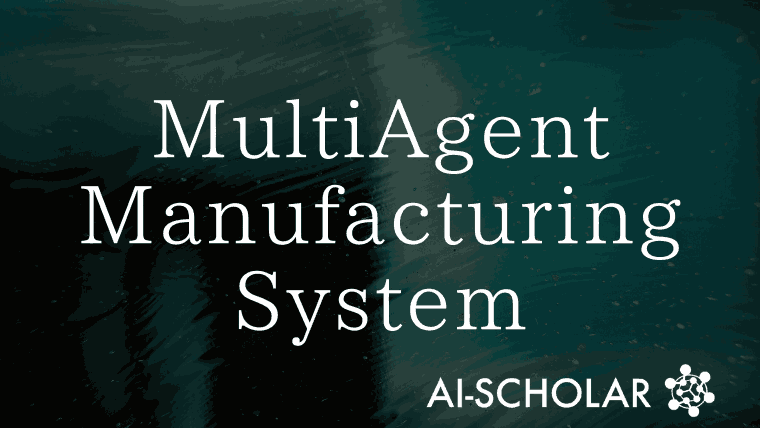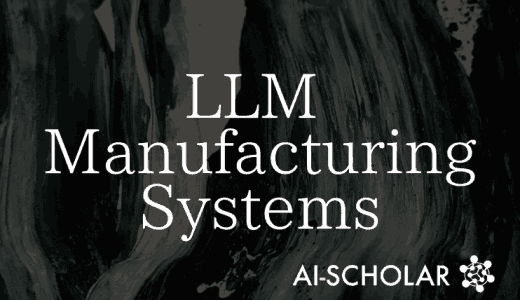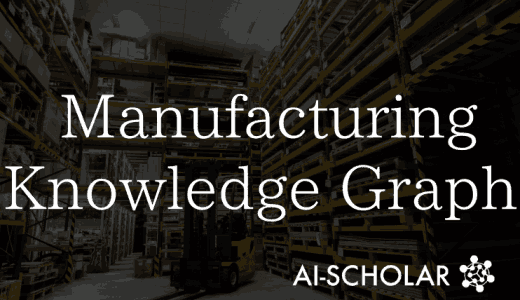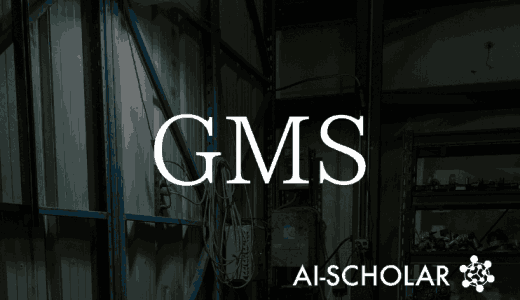
Next-generation Manufacturing System Using Multi-agents Based On Large-scale Language Models
3 main points
✔️ Large-scale language models for intelligent multi-agent systems and specifying how they cooperate
✔️ Dynamic management of flexible manufacturing resources for efficient scheduling methods
✔️ Performance verification of LLM-based systems through experiments and comparison with other methods
A Large Language Model-based multi-agent manufacturing system for intelligent shopfloor
code:
written by Zhen Zhao, Dunbing Tang, Haihua Zhu, Zequn Zhang, Kai Chen, Changchun Liu, Yuchen Ji
[Submitted on 27 May 2024]
Comments: Accepted by arXiv
Subjects: Artificial Intelligence (cs.AI); Multiagent Systems (cs.MA); Robotics (cs.RO)
The images used in this article are from the paper, the introductory slides, or were created based on them.
Summary
As productivity increases, customer demand for high-mix, low-volume production is increasing, which in turn places greater demands on manufacturing systems. When this demand results in frequent changes in production tasks, traditional manufacturing systems are often unable to respond quickly. To solve this problem, the authors propose a multi-agent manufacturing system. However, due to technical limitations, negotiations between agents in this type of system are realized based on predefined heuristic rules and are not intelligent enough to handle high-mix low-volume production.
We propose a Large Language Model (LLM)-based multi-agent manufacturing system for intelligent store floors. The system defines a variety of agents and specifies how they cooperate. Agent roles include Machine Server Agent (MSA), Bid Inviter Agent (BIA), Bidder Agent (BA), Thinking Agent (TA), and Decision Agent (DA). with the support of LLM, TA and DA can analyze the store floor Negotiations between the BA and BIA are the most important step in linking manufacturing resources, and with the support of the TA and DA, the BIA finalizes the distribution of orders based on the information returned by each machine. floor and is responsible for connecting the agents to the physical shop floor. The system aims to distribute and transmit workpieces through the cooperation of agents, a feature that distinguishes it from other scheduling methods. Comparative experiments were also conducted to verify the performance of this system.
Introduction
As productivity increases, customers' unique product requirements are becoming increasingly frequent. This high-mix, low-volume demand requires frequent changes in manufacturing resources and places increased demands on the capabilities of the manufacturing system. Manufacturing systems are responsible for organizing manufacturing resources within a store floor or larger area for efficient production.
Traditional production methods require the production scheduler to adjust workpieces based on experience and real-time shop floor conditions. Manual scheduling requires cooperation with multiple machines and departments, sets long-term schedules, and is usually inflexible to change. This rigidity makes it difficult to respond to the fluctuating demands of production. Traditional manufacturing is suited for large-scale production and focuses on uniform, standardized workpieces. However, production of individual custom products requires high-mix, low-volume production, and building dedicated production lines is economically and efficiently inappropriate.
In this regard, flexible manufacturing is emerging as a more suitable alternative. Flexible manufacturing organizes the processing of products according to several scheduling methods, allowing for the production of complex and variable products. Currently, scheduling methods in flexible manufacturing are mainly implemented using heuristic rules, meta-heuristic algorithms, and deep reinforcement learning (DRL) algorithms.
Heuristic rules are designed by human intelligence and provide a quick response, but have poorer performance compared to subsequent methods. Meta-heuristic algorithms use calculations to generate scheduling solutions that take into account current production orders and manufacturing resources. However, this method is iteratively time-consuming and usually poorly coordinated when orders or resources change; the DRL algorithm provides a more efficient way to quickly find a scheduling solution and deal with dynamic disturbances. The performance of metaheuristics and DRL is excellent for scheduling small manufacturing resources, but as manufacturing resources increase, the complexity of these algorithms increases rapidly and performance degrades.
In this context, the authors propose a new approach: a multi-agent manufacturing system utilizing large-scale language models (LLMs). This system does not rely on traditional heuristic rules or meta-heuristic algorithms, but rather leverages the natural language processing capabilities of LLMs to achieve a more sophisticated negotiation mechanism. utilizing LLMs allows for more flexible and intelligent negotiation among agents, and enables optimal machine selection for high-mix low-volume production, and enables optimal machine selection for high-mix, low-volume production.
Related Research
LLM's multimodal capabilities introduce new intelligence into manufacturing systems. Current scheduling methods are mainly based on meta-heuristic and DRL algorithms. This section presents existing research on scheduling methods and LLM applications in manufacturing systems.
Scheduling Methodology for Manufacturing Systems
- Meta-heuristic algorithms: highly accurate but slow to solve, suitable for static scheduling problems.
- Example: Liu et al. developed a mathematical model for flexible job store dual-resource batch scheduling and tested its effectiveness in a real-world scenario.
- Deep Reinforcement Learning (DRL) algorithm: requires pre-training to deal with dynamic scheduling problems.
- Example: Zhou et al. introduced an AI-based system for dynamic scheduling in smart factories that uses a composite reward function to improve multi-objective performance metrics.
- Other methods: multi-agent manufacturing systems are effective for transitioning and expanding manufacturing systems because of their rapid processing speed and lack of pre-training requirements.
- Example: Qin et al. introduced the comprehensive concept of self-organizing manufacturing networks and positioned this as the next generation of manufacturing automation technology.
LLM Applications
- Biology: Researchers are using LLM to make significant progress in the field of biology.
- Example: Boiko et al. implemented Coscientist, an AI system based on GPT-4, to automate the design, planning, and execution of complex experiments.
- Chemistry: LLM is used to understand and quickly apply chemistry tasks.
- Example: Jablonka et al. fine-tuned GPT-3 to develop a model that correctly answers chemistry questions in natural language.
- Robotics and Manufacturing: LLM implementation is also important in the robotics and manufacturing sectors.
- Example: Ichter et al. combined low-level skills with LLM to provide high-level knowledge to improve the performance of a robot performing complex procedures.
Research Gap
- Currently, LLM applications are progressing in a variety of areas, but few applications, especially in manufacturing systems.
- Flexible manufacturing resource scheduling is based primarily on meta-heuristic and DRL algorithms.
- Traditional multi-agent manufacturing systems rely on a single heuristic rule and are not capable of machine selection based on real-time conditions.
LLM-Based Multi-Agent Manufacturing Framework
This study proposes an LLM-based multi-agent manufacturing system consisting of an LLM engine layer, a negotiation layer, and a physical resource layer, as shown in Figure 1. The characteristics of this system and the role of each layer are as follows

| Figure 1 LLM-based multi-agent manufacturing framework |
LLM Engine layer
The LLM engine layer provides the LLM engine; LLM inference and training require large GPUs, but these are not available in the factory. Therefore, communication between the manufacturing system and the LLM deployed in a computer center with multiple GPUs is established via an API, allowing the manufacturing resource agents on the store floor to operate more effectively.
For application scenarios that are very sensitive to data security, open source LLM (e.g., Large Language Model Meta AI (LLaMA)) can be an alternative. However, this will definitely affect the performance of the agent.
Negotiation Layer
This layer serves as the critical middleware through which LLM and manufacturing resources interact. There are many different types of manufacturing resources on the store floor, which can be effectively abstracted and interpreted as machines. For example, a raw materials warehouse, traditionally used to ship orders, can be conceptualized as a machine with zero processing time.
As shown in Figure 2, the negotiation process between agents involves the following steps
- Event Triggering: Each machine is equipped with a Machine Server Agent (MSA) that monitors the machine. When a processing decision is made, the MSA initiates the next step, activating the BIA (Bid Inviter Agent).
- Bidder Preparation: triggered by the MSA, the BIA prepares the work piece information needed for the next available machine.
- Invitation of Bidders: The BIA invites available BAs (Bidder Agents) and informs them of work pieces to be processed.
- Bid Preparation: Upon receiving an invitation, the BA prepares a bid document, which includes relevant machine information and work piece analysis.
- Delivery of bid documents: all BAs deliver bid documents to the initial BIA.
- Question document generation: BIA receives documents from the BA and generates a question document integrating store floor information and optimization goals.
- Question document delivery: The BIA sends the generated question documents to the TA (Thinking Agent) that is linked to the LLM.
- Proposal Generation: The TA utilizes LLM's multimodal capabilities to generate a comprehensive solution to the question document.
- Proposal Delivery: The TA sends the generated proposal to the Decision Agent (DA).
- Decision generation: The DA makes the final decision based on suggestions from the TA.
- Decision delivery: The DA sends the final decision to the BIA, which triggers the MSA to achieve processing of the workpiece.

| Figure 2: Negotiation Process for Manufacturing Agents |
Physical Resource Layer
This layer includes all physical entities located on the store floor. In this layer, each manufacturing resource is connected to the manufacturing system. via IIOT (Industrial Internet of Things), this layer is linked to the negotiation layer. event triggers in the MSA activate the negotiation layer and when a manufacturing resource needs a decision The negotiation process is initiated. Similarly, a decision trigger sends the decision from the negotiation layer back to the relevant manufacturing resource.
Figure 3 details the negotiation process between agents in an LLM-based multi-agent manufacturing system. This process allows agents to select the best machine based on real-time conditions and efficient scheduling.

| Figure 3: Example of agent negotiation in an LLM-based multi-agent manufacturing system |
Negotiating Agents in Manufacturing Systems
This section details how agents achieve their negotiation capabilities. A concrete example of an agent's negotiation within a manufacturing system is provided, as illustrated in Figure 3.
-
Machine Server Agent (MSA)
- The MSA serves as a bridge between physical manufacturing resources and other agents. It provides a link to intelligent manufacturing systems.
- Example: The MSA sample code is programmed in C# and controls a milling machine. Each MSA corresponds to a manufacturing resource and cooperation between MSAs detects the arrival of decision time.
-
Bid Inviter Agent (BIA)
- BIA is directly involved in the bidding process and works with MSA. With the help of other agents, it specifies the next processing machine for the current workpiece.
- Example: upon receipt of an event trigger, the BIA will filter the BAs needed to complete the following process and invite bids.
-
Bidder Agent (BA)
- The BA will generate bid documents and work with the MSA. The bid document will include information on the condition of the machine and analysis of the work piece.
- Example: After receiving the invitation, the BA obtains the relevant machine status from the MSA, prepares a bid document and sends it back to the BIA.
-
Thinking Agent (TA)
- The TA grants intelligence to other agents and uses LLM to make decisions; the TA selects the best BA based on the question document received from the BIA.
- Example: Use the Markdown format to define LLM behavior from multiple angles. Utilize chain-of-sort to guide the decision process step-by-step.
-
Decision Agent (DA)
- The DA makes the final decision, and based on the results of the TA analysis, makes the best decision. The decision result is sent to the BIA and executed by the MSA.
- Example: The DA receives the written analysis from the TA, extracts the final decision and communicates it to the BIA.
Figure 4 details the Thinking Agent and Decision Agent and illustrates how the Markdown format can be used to define the agent's characters, goals, knowledge, answers, and constraints.

| Figure 4: Detail of Thinking and Decision-Making Agents |
Experiment
Several experiments were conducted to verify the performance of the proposed LLM-based multi-agent manufacturing system. The experiments were conducted on the Flexible Job Shop Scheduling Problem (FJSP).
Verification Experiment
Selected test instances were used to verify the applicability of the system. In these instances, the number of machines varied from 5 to 15 and the number of orders from 10 to 30.
As a comparison, the following methods were introduced as benchmarks
- Shortest Machine Processing Time (SMPT ): Select the machine with the shortest operation processing time
- Work in Queue (WINQ): select the machine with the least amount of work
- Random: Randomly select a machine
- First In First Out (FIFO), First In Last Out (FILO), and Shortest Processing Time (SPT) as heuristic rules
Comparative results for the test instances are shown in Tables 1, 2, and 3. These tables show that the proposed system outperforms the other approaches in most cases.
- Table 1: Make span in test instances with FIFOs

- Table 2: Make Span in Test Instances with FILO

- Table 3: Make Span in Test Instances with SPT

Figures 5(a) and 5(b) show the Gantt chart of mk01 with FIFO, illustrating the evenly distributed workload of the proposed system.

| Figure 5 Gantt chart of machine selection by FIFO for mk01 |
Figures 6(a) and 6(b) are Gantt charts for mk15 with FILO, showing that the proposed system can effectively handle large problems.

| Figure 6 Gantt chart of machine selection by FILO in mk15 |
Applications of LLM-Based Multi-Agent Manufacturing Systems
-
To verify the practicality of the proposed system, the system was tested in an intelligent manufacturing factory lab in Wuxi. In this lab, automatic control of manufacturing resources is achieved using MSA.
-
Figure 7 shows an intelligent factory testbed for evaluating LLM scheduler performance in a physical case study.

| Figure 7 Intelligent Factory Testbed for Performance Evaluation of LLM Scheduler with Physical Case Study |
-
Figure 8 shows the makespan for the different scheduling approaches, illustrating the superiority of the proposed system over other methods.

| Figure 8: Make Span Corresponding to Scheduling Approach |
Figures 7 and 8 show that the proposed system can adapt to different workpiece selection methods. In particular, the WINQ results are always shown to be worse than random, indicating that a single heuristic rule is difficult to adapt to different problems, a problem that does not occur in the proposed system.
Conclusion
The rapid development of Large Scale Language Models (LLMs) has opened up new possibilities for multi-agent manufacturing systems, and to incorporate the powerful capabilities of LLMs into manufacturing systems, this study proposes an LLM-based multi-agent manufacturing system for an intelligent store floor. The framework defines agents for the manufacturing resources of a physical store floor and supports the entire process from control to decision making.
The proposed system has multiple agents for store floors and factories and defines how agents cooperate with each other. Defined agents include Machine Server Agent (MSA), Bid Inviter Agent (BIA), Bidder Agent (BA), Thinking Agent (TA), and Decision Agent (DA). the TA and DA are directly connected to the LLM and are compatible with several The BA and BIA work together to enable information exchange between the various manufacturing resources.
The essence of an agent is not an abstraction unique to each individual, but a collection of production relationships. Cooperation among agents allows the LLM-based manufacturing system to negotiate production autonomously. In the cooperation process, the information in this system uses natural language, which greatly reduces the cost of maintenance and modification of the proposed system.
Experiments were conducted on several test instances to verify the performance of the proposed system. These experiments confirmed that the proposed system performs better than other methods. The system was also tested in a physical intelligent manufacturing plant lab to verify its practicality.
Future studies will include additional optimizations to improve system flexibility and efficiency for application in more real-world manufacturing environments.
Categories related to this article







